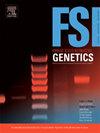Preparing for shotgun sequencing in forensic genetics – Evaluation of DNA extraction and library building methods
IF 3.2
2区 医学
Q2 GENETICS & HEREDITY
引用次数: 0
Abstract
Shotgun sequencing can be a powerful tool in forensic genetics, enabling comprehensive genetic analyses of biological samples for human identification (HID), forensic DNA phenotyping, ancestry inference, and forensic investigative genetic genealogy (FIGG). This study evaluated the performance of shotgun sequencing of typical forensic reference samples (whole blood or punches from FTA cards) extracted with four commonly used DNA extraction methods. The four DNA extraction methods were paired with three different library building methods to determine the best combination of procedures and their impact on the quality and quantity of the sequencing reads. Shotgun sequencing was performed on an Illumina NovaSeq 6000 system. The data was analysed for coverage, total number of reads, mapped reads, median insert size, and presence of forensically relevant loci, including short tandem repeats (STRs), ancestry informative markers (AIMs), single nucleotide polymorphisms (SNPs) associated with pigmentary traits (HIrisPlex-S), SNPs on the Y chromosome, and SNPs used for FIGG. The highest quality of sequencing data was achieved using the combination of EZ1&2 DNA Investigator Kit extractions and a double-stranded library building method, or the combination of Chelex® or PrepFiler Express™ Forensic DNA Extractions with a single-stranded library building protocol. The combination of EZ1&2 DNA extraction and double-stranded library building yielded the largest number of genotypes. As many as 36 STRs, 162 AIMs, 41 HIrisPlex-S SNPs, 85,712 Y-SNPs, and 1.3 million FIGG SNPs were genotyped in one experiment. On the contrary, the combination of Chelex® or PrepFiler™ together with a double-stranded library building method generated relatively few genotypes and low-quality results. The single-stranded library building protocol could be applied to EZ1&2 DNA Investigator Kit extractions of DNA on FTA cards but was inefficient and generated low-accuracy data when the sample material was whole blood. In conclusion, this study highlights the importance of combining the different forensic DNA extraction methods with appropriate shotgun sequencing library preparation approaches to optimise both the quantity and quality of forensically relevant DNA data.
法医遗传学中鸟枪测序的准备。DNA提取和文库建立方法的评价
霰弹枪测序是法医遗传学的一个强大工具,可以对生物样本进行全面的遗传分析,用于人类鉴定(HID)、法医DNA表型、祖先推断和法医调查遗传谱系(FIGG)。本研究评估了四种常用DNA提取方法提取的典型法医参考样本(全血或FTA卡片上的穿孔)的霰弹枪测序性能。将这四种DNA提取方法与三种不同的文库构建方法配对,以确定最佳方法组合及其对测序reads质量和数量的影响。在Illumina NovaSeq 6000系统上进行鸟枪测序。分析数据的覆盖率、总读取数、映射读取数、中位插入长度和法医相关位点的存在,包括短串联重复序列(STRs)、祖先信息标记(AIMs)、与色素性状相关的单核苷酸多态性(SNPs) (HIrisPlex-S)、Y染色体上的SNPs和用于FIGG的SNPs。使用EZ1&;2 DNA研究者试剂盒提取和双链文库构建方法的组合,或Chelex®或PrepFiler Express™法医DNA提取与单链文库构建协议的组合,可以获得最高质量的测序数据。EZ1&;2 DNA提取和双链文库构建相结合得到的基因型数量最多。在一个实验中,多达36个str、162个AIMs、41个HIrisPlex-S snp、85,712个y - snp和130万个FIGG snp被基因分型。相反,Chelex®或PrepFiler™与双链文库构建方法的结合产生相对较少的基因型和低质量的结果。单链建库方案可用于EZ1&;2 DNA研究者试剂盒提取FTA卡上的DNA,但当样品材料为全血时,效率低,数据准确性低。总之,本研究强调了将不同的法医DNA提取方法与适当的霰弹枪测序文库制备方法相结合的重要性,以优化法医相关DNA数据的数量和质量。
本文章由计算机程序翻译,如有差异,请以英文原文为准。
求助全文
约1分钟内获得全文
求助全文
来源期刊
CiteScore
7.50
自引率
32.30%
发文量
132
审稿时长
11.3 weeks
期刊介绍:
Forensic Science International: Genetics is the premier journal in the field of Forensic Genetics. This branch of Forensic Science can be defined as the application of genetics to human and non-human material (in the sense of a science with the purpose of studying inherited characteristics for the analysis of inter- and intra-specific variations in populations) for the resolution of legal conflicts.
The scope of the journal includes:
Forensic applications of human polymorphism.
Testing of paternity and other family relationships, immigration cases, typing of biological stains and tissues from criminal casework, identification of human remains by DNA testing methodologies.
Description of human polymorphisms of forensic interest, with special interest in DNA polymorphisms.
Autosomal DNA polymorphisms, mini- and microsatellites (or short tandem repeats, STRs), single nucleotide polymorphisms (SNPs), X and Y chromosome polymorphisms, mtDNA polymorphisms, and any other type of DNA variation with potential forensic applications.
Non-human DNA polymorphisms for crime scene investigation.
Population genetics of human polymorphisms of forensic interest.
Population data, especially from DNA polymorphisms of interest for the solution of forensic problems.
DNA typing methodologies and strategies.
Biostatistical methods in forensic genetics.
Evaluation of DNA evidence in forensic problems (such as paternity or immigration cases, criminal casework, identification), classical and new statistical approaches.
Standards in forensic genetics.
Recommendations of regulatory bodies concerning methods, markers, interpretation or strategies or proposals for procedural or technical standards.
Quality control.
Quality control and quality assurance strategies, proficiency testing for DNA typing methodologies.
Criminal DNA databases.
Technical, legal and statistical issues.
General ethical and legal issues related to forensic genetics.

 求助内容:
求助内容: 应助结果提醒方式:
应助结果提醒方式:


